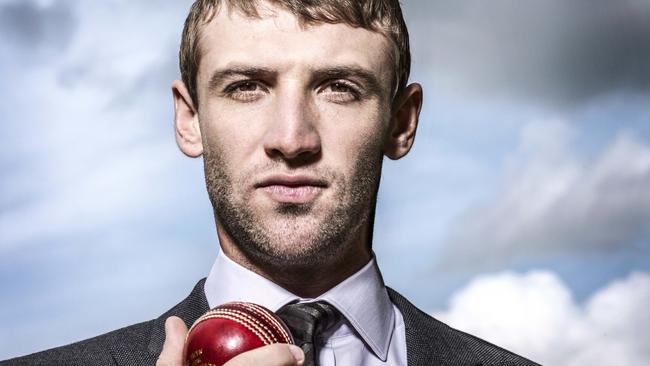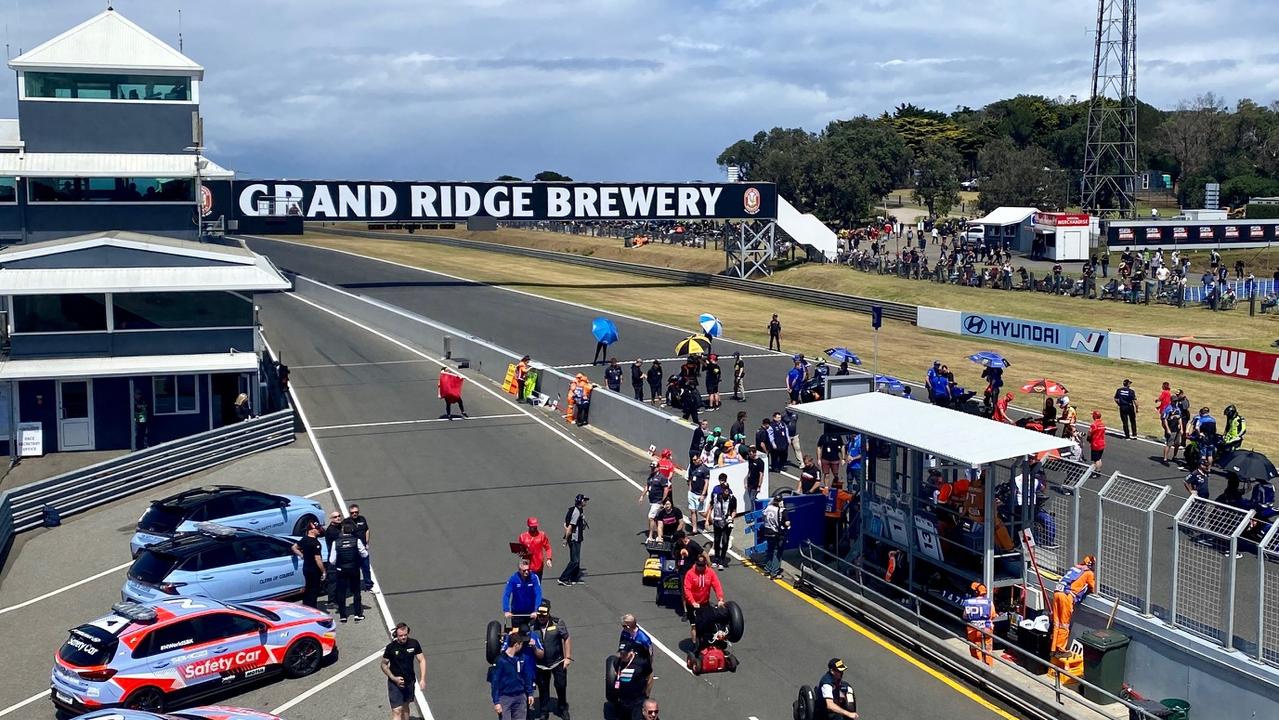Phillip Hughes dies: How his last day on the pitch unfolded
PHILLIP Hughes stepped up to the crease and was soon on his way to what promised to be his 27th first-class century. Then the world stopped. | Queen’s message to family | Google’s tribute

News
Don't miss out on the headlines from News . Followed categories will be added to My News.
IT began as a day filled with promise — and ended in the most unimaginable tragedy.
Phillip Hughes was stepping up to the crease at the Sydney Cricket Ground with a return to the Test team next week in his sights.
The swashbuckling 25-year-old batsman had left NSW and joined the South Australian Redbacks to revitalise his international career, and injury to his close friend and Australian captain Michael Clarke had created the opening.
Hughes flew into Sydney on QF740 — a Monday morning Qantas flight — that landed him in his home state around 10:30am. He travelled with the South Australian team to the SCG for some light training.
CLARKE TO MAKE STATEMENT ON BEHALF OF TEAM
FIRST TEST AGAINST INDIA NOW IN DOUBT
HAVE YOU #PUTOUTYOURBATS FOR HUGHES?
INJURY SO RARE, HOSPITAL HADN’T SEEN IT BEFORE
SON BLESSED WITH THE FATHER OF ALL BELIEVERS
WORLD RALLIES BEHIND SEAN ABBOTT
It was hot and muggy, an afternoon punctuated by a vicious electrical storm that swept across the city.
Hughes and the Redbacks players wrapped up their session and drove to their hotel — the Adina apartments on Crown St, Surry Hills — for a team meeting.
Skies bellowed ominously outside as gusts of wind, torrential rain and lightning battered Sydney.
The South Australians ate dinner and scattered to their respective rooms. Phillip Hughes was with Tom Cooper.
On Tuesday, he woke early and ate breakfast at nearby Bills restaurant, an institution owned by Bill Granger and famed for its egg dishes.
The storm had passed, temperatures eased. It looked like a good day, filled with promise and the chance of a return to the Test side.
After breakfast, the team again divided and made the 1200m trip to the SCG in mini-vans. They arrived around 8.30am.
The batsmen among the Redbacks, including Hughes, faced up in the nets adjacent to the ground for a quick practice session against the bowling attack.
He looked in good form, had his eye in.
The toss came at 9.45am — won by South Australian captain Johan Botha who opted to bat first.
In the historic visitor’s dressing room, Hughes strapped on his pads, laced up his boots, put on his helmet and performed some shadow batting.
Those who knew the tiny left hander noticed a steely determination in his manner as he walked out to open in the Sheffield Shield match against a superstar NSW attack.
His rivals for the coveted Test spot were all batting at the same time — Alex Doolan in Brisbane, Shaun Marsh in Melbourne and, at the other end of the wicket in Sydney, Callum Ferguson.
Hughes had it all to play for. National selector Mark Waugh was among the modest crowd. Hughes was composed, sending the ball driving through the covers for fours and in the middle of the innings pulling off his signature shot, dropping to one knee for a superb cut that sizzled out to a fielder.
At 61 he stalled for seven-and-a-half overs before a two set him on his way to what promised to be his 27th first-class century.
In the stands his mother Virginia and sister Megan watched rapt as bowler Sean Abbott, Hughes’s former teammate, ran up in the middle of the 49th over to deliver the 161st ball Hughes had faced that day.
It was 2.23pm on Tuesday, November 25. The 163g ball reached a speed of 135kmh before bouncing wickedly. Hughes attempted a hook shot and the ball hit him on the neck beneath his helmet.
The world stopped.
Hulking paceman Jacques Kallis runs his scuffed fingers through what is left of his receding mane, and stares.
He has always stared, mid pitch, post delivery, eyes full of feigned hatred. Or not feigned at all. It’s his routine standover tactic in his all-too-successful attempt to climb under the sweating, goose bump skin of a novice opponent and cause some palpitations; an `I’m your worst nightmare’ type of stare.
But this is a different stare. It smacks of bewilderment, confusion. Of sheer befuddlement.
He sucks in a deep breath and is unable to hide the sigh, pushed out forcibly through cracked lips pursed to blow out 100 candles.
Phillip Hughes has just slashed one of his deliveries to the cover boundary and brought up his half century.
A fricken 20-year-old. Some plucky kid from the Aussie bush whose cut shot looks decidedly ungainly and whose feet movement would look more at home at a West Virginian barn dance.
Kallis stares, huffs, his mind no doubt trying to properly gauge his fresh-faced foe _ ‘who is this upstart?’
The world’s best all-rounder will eventually get his man, tempting him with a short and wide delivery outside off, but not before the kid from Mackville has put 115 runs on the board, cracked 88 runs by thumping a ball into the boundary, or clearing it, and lulled the zealous Durban crowd into a daze.
He smacks four boundaries off a single Morne Morkel over, reducing the beanpole to padded cell material.
It is March 6, 2009, and Phillip Joel Hughes has announced himself to the world, knocking up his first century in a blaze of unorthodox but entertaining batting, in only his second Test appearance.
Devoted Australian fans of the red ball knew this moment was possible, having witnessed his First Class numbers rise rapidly in a stellar introduction to Sheffield Shield. But this was Durban, the pitch was green and biting, and all señor Kallis and his Protea pals had seen was an embarrassing first Test duck and a rather meaningless half century that only partially erased the former glitch.
“A week ago the hosts did not think he could play. They looked at his technique and concluded that he was scared. Suffice to say they have changed their minds,’’ cricket columnist Peter Roebuck opined.
This was not a carefully crafted, tentative innings from a nervous boy, just 98 days out of his teens. It was both swash buckling and dangerous, perhaps best summarised by two shots either side of his century _ a bold six over mid-on off the bowling of Paul Harris to take him to 99, and another wretched over the fence the next ball, his knee touching the ground in the awkward twisting motion. Straight out of the Mackville backyard textbook; as elegant as an inebriated giraffe.
“What a way to get to your first Test 100,’’ the astonished local commentator quipped.
Importantly, in his wake was the world’s most potent attacking force _ Dale Steyn, Makhaya Ntini, Morkel and Kallis, each devoid of ideas to contain this smiling minion.
Former teammate of Don Bradman Arthur Morris was asked for his thoughts after Hughes’ promising start. The history books will one day speak glowingly of the lad, Morris predicted.
“His batting has been extraordinary,’’ he said after the first innings, ``because he has been facing a pretty good bowling attack. I thought he was a great player in the making and now he’s finally arrived.’’
It is much the same result when the Australians march out onto the famously wild pitch for their second innings, albeit this is now a different Hughes, a less urgent Hughes, a Hughes prepared to show he can play a steady hand when called upon. Zen-like. Anything wide of off stump, however, is dispatched, including a cut to the boundary off Morkel to bring up his second ton, sending statisticians scrambling for their frayed Wisdons. They pencil in a new entry: the youngest player to score twin tons in a Test in the game’s history.
He finishes on 160 and leaves the hosts with an improbable 545 runs to chase in their last stint. Good luck.
Captain Ricky Ponting spent some valuable time in the middle watching Hughes up close, encouraging him to shut his ears to the constant abuse being cast upon the youngster. He knew he was staring at something special. Someone special.
“Every time (he was sledged), he would just look at me with a smile on his face and tell me that he was loving it. That’s what Test cricket is all about. It’s about that one-on-one contest that you get into. Phil showed that he really enjoys that. If he continues to do that as much as he has over the last couple of weeks, I’m sure he’ll have a great career,’’ Ponting claimed.
Sitting behind the glass in the nosebleed section of Kingsmead stadium, the team’s batting coach Justin Langer was fulsome in his praise for his emerging young gun. He had intimate knowledge of what was required to rise above a setback, ignore the sledging, and forge a path of greatness from the heaviness of the top order.
“For a young fella, he must have a mind like steel,’’ he said.
“There was all the talk about Test selection … and then he made the duck and then (the South Africans) talked about a new plan about bouncing him, and what did he do? He just kept grinning at them _ he’s like a little smiling assassin.
“He’s under pressure on and off the field, and now he’s peeled off two hundreds. It’s just extraordinary. I can’t remember being this pumped for a young player ever.’’
When the son of a banana farmer arrived in England that northern summer, he was no longer a mystery, a name without renown.
And four scintillating innings for Middlesex in the lead-up to the Ashes cemented that prominence, nay, notoriety in learned English minds. Four innings, 574 runs at an average of 143.5. Bradman-esque.
But just as the Bradman comparisons were vented and remained fresh in London air, just as the superlatives began to stockpile, Hughes was dropped within two Tests.
With the popular batsman no longer here to make those premature Bradman prophesies eventually materialise, the cricket world will always have Kingsmead; those twin tons by a 20-year-old prodigy.
When an unassuming, quiet lad from the bush became an almighty giant killer.
The young batsman stood momentarily with his hands on his knees before pitching face forward into the turf.
All hell broke loose. The players and umpires ran to his aid and immediately called for help. NSW doctor John Orchard led the medical team on to the field. It was bad.
Former Australian paceman Trent Copeland was watching at the SCG and said: “Immediately you could tell there was something wrong. The players around him were freaking out.”
The ball had split the artery in Hughes’s neck and blood was already pumping into the space between his brain and skull.
Fellow batsman David Warner made frantic signals for staff to phone an ambulance and then ran to the boundary to make sure the message was delivered. The triple-0 call was made at 2.29pm.
At NSW Ambulance nearby crews were all delayed at hospitals waiting to offload patients and the nearest ambulance was 10km away in Summer Hill.
By now Hughes had been moved to the sidelines where Dr Orchard administered CPR. He was joined by Newcastle intensive care specialist Dr Timothy Stanley who had been watching from the stands.
Out on Driver Ave wicketkeeper Peter Nevill was standing in his whites looking for the ambulance. A second call to emergency services at 2.37pm brought an ambulance to the SCG seven minutes later. Paramedics sprang into action.
The original ambulance finally arrived at 2.52pm and was joined by another ambulance and a doctor on a NSW Ambulance helicopter at 3.05pm who helped insert a tube to open the batsman’s airway.
Finally Hughes was driven to St Vincent’s Hospital just 1.5km away and was immediately rushed in for CAT scans followed by surgery lasting one hour and 20 minutes to remove part of his skull to relieve the pressure on his brain.
By just after 5pm, instead of declaring his century, Hughes was in intensive care in an induced coma with his family, cricketing friends and an anxious Australian nation watching on.
He never woke up.


